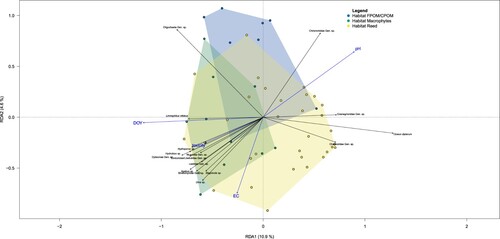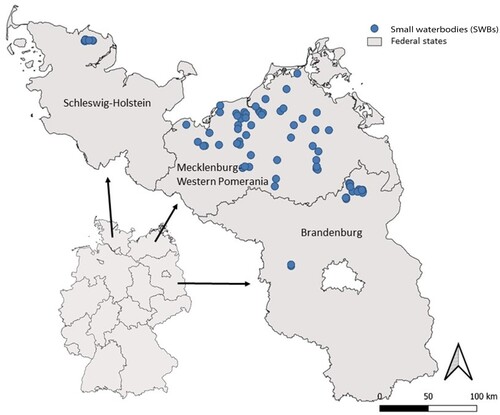Figures & data
Table 1. Structural composition of communities of waterbodies in arable- and grassland-dominated fields based on 102 samples from arable land and 9 samples from grassland sites. Values in brackets indicate standard deviation. Bold = based on taxonomically harmonized dataset.
Table 2. Overview of environmental parameters and day of sampling based on 102 samples from arable land and 9 samples from grassland sites. Values in brackets indicate standard deviation.
Table 3. Results for the model-averaged coefficients (full average) of the GLMs. Significant p values are given for the variables. Significant interaction terms are listed in the last column with their respective p value. For all response variables a Gaussian family link was used. n = number of samples in the dataset, DOY is day of year, T is temperature, EC is electrical conductivity.
Table 4. Results of the PERMANOVA run separately for the grouping variables. The values give the difference between the groups in percent. Values in brackets are the p values. n = number of samples in the dataset. Five habitat types† (CPOM, FPOM, reed, macrophytes, and others; 3 habitat types‡ (CPOM/FPOM, reed, macrophytes).
Table 5. Contributions of species to differences between groups. For each dataset and variable, the first 5 species are shown with their respective contribution (averages) to the group differences. Values are given in percent. Calculated using the simper function, vegan package in R (Oksanen et al., 2022). Community data for this analysis was presence–absence transformed.
Table 6. Results from the pRDA. Latitude and Longitude used as input for the conditioned variance. Variable outcome from the backward selection of the RDA plus toxicity and number of habitats. Hellinger-transformed dataset used. n = number of samples in the dataset.
Figure 2. Ordination diagram of first 2-axis pRDA analysis based on the Hellinger-transformed abundance data, conditioned for spatial variation. Environmental parameters with continuous values (DOY, toxicity, EC, pH) are shown as blue arrows. Environmental parameter habitat described as a factor is shown as colored polygons. Species that explain at least 25% of variation are shown as black arrows. Gen. sp. denotes grouping that includes genera/species

Supplemental Material A
Download MS Word (12.9 KB)Supplemental Material B
Download MS Word (37.6 KB)Supplemental Material C
Download MS Word (12.9 KB)Supplemental Material D
Download MS Word (20.1 KB)Supplemental Material E
Download MS Word (13.5 KB)Data availability statement
Due to the sensitive nature of the questions asked in this study, farmers were assured raw data would remain confidential and would not be shared, and respondents would not be identified individually. All data on the analytical methods can be requested from the authors.

